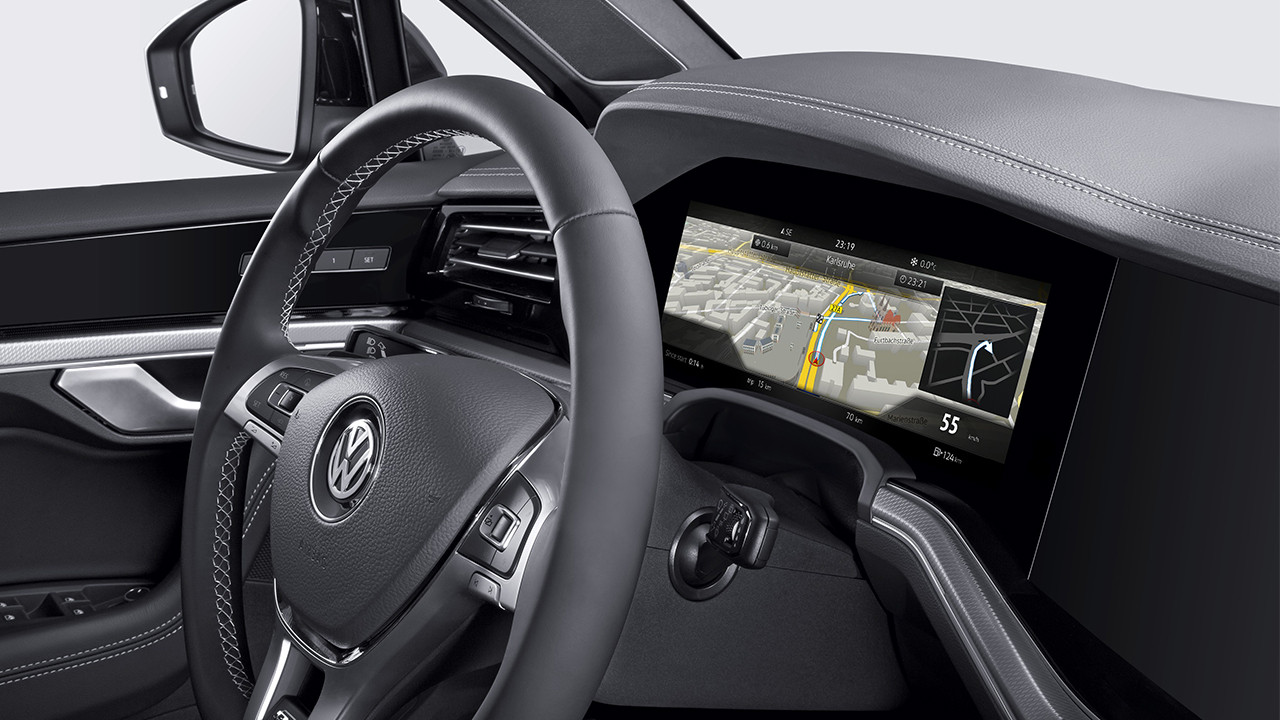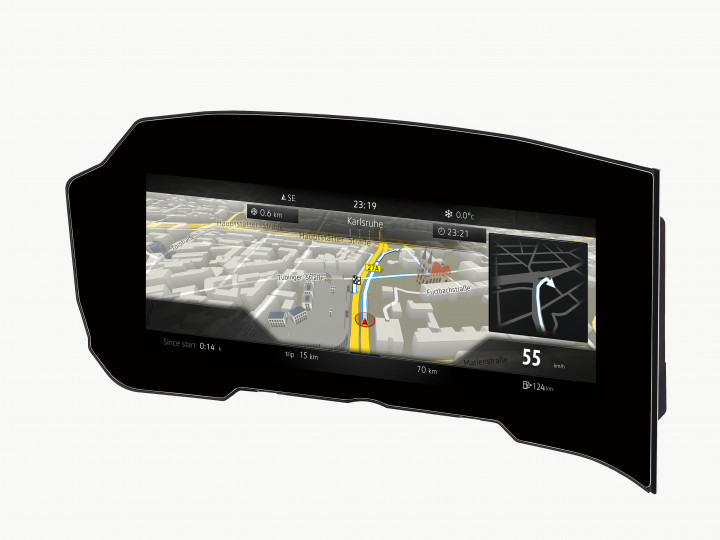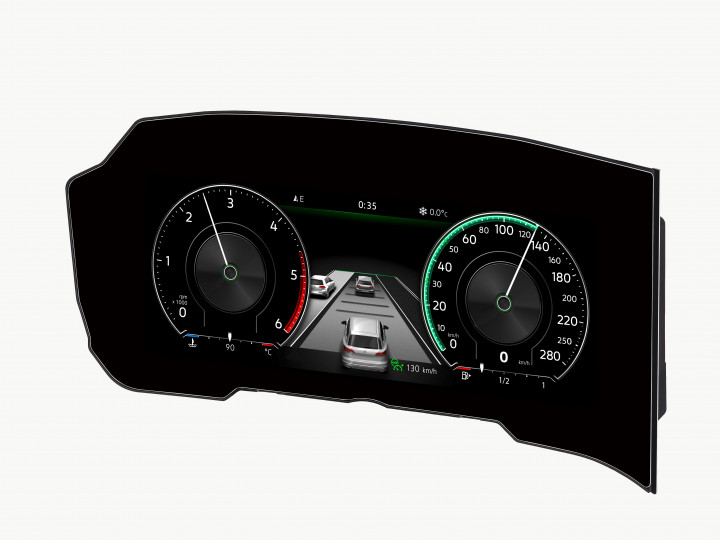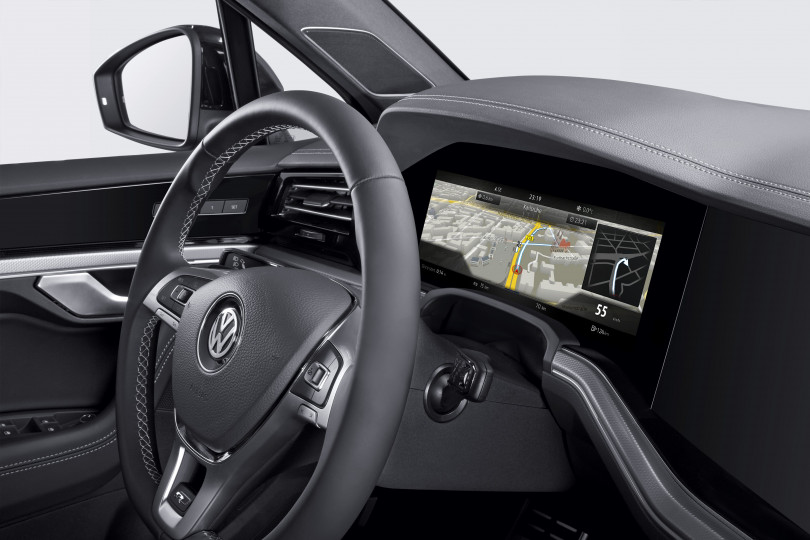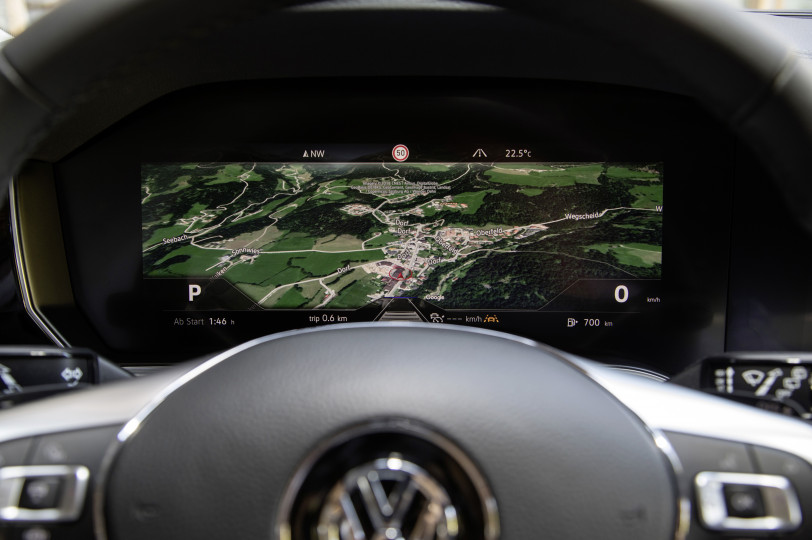Hildesheim – A mind-bending achievement: Bosch is putting the world’s first curved instrument cluster in the cockpit of a mass-production vehicle. What has long since arrived in people’s living rooms at home and for the smartphone is now being put on the road by Bosch as the first of its kind in mass production. “The days of flat instrument displays are over. With the world’s first curved instrument cluster, Bosch is opening up a new dimension in vehicle cockpits,” says Steffen Berns, president of the Car Multimedia division. The “curved” instrument cluster will be celebrating its debut in the Innovision Cockpit of the new VW Touareg. This means that Volkswagen is now replacing analog display technology behind the steering wheel with a freely configurable, high-resolution, curved display. Depending on what the driver wants to see at any given time, the screen is able to display large-area navigation maps, driver information or the status of the assistance systems. The secret behind the sharpness and contrast of the new displays is a new manufacturing process, with which the instrument cluster reflects more than four times less light, even in the sunlight.
More safety, more space, more freedom
These days, everyone knows that the world is not flat. With a consistently digital, curved instrument display, Bosch is now proving that instrument clusters in the vehicle also no longer have to be flat. Its curvature mimics the natural curvature of the human eye. As a result, the driver is able to much better detect indicator lights and warning signals, even at the edge of the screen. This also gives it a clear advantage over the familiar curved monitors at home in the living room, where only one person can sit at the optimum viewing angle at any one time. In contrast, the curved instrument cluster in a vehicle always optimally accommodates the driver’s view. “Drivers benefit from curved instrument clusters in terms of safety and convenience. At the same time, this type of display gives automotive manufacturers greater freedom and more space in the design of the cockpit,” says Berns. Nowadays, automotive manufacturers increasingly want to avoid using mechanical switches, knobs, and controls. However, large-sized monitors are very high on the wish list – as is the curved instrument cluster made by Bosch. Beneath its surface, it combines a large number of digital displays, while taking up almost two centimeters less space than a non-curved screen of comparable size.
“Whatever you want” in the cockpit
Speedometer, navigation maps, and telephone list: the contents displayed on the instrument cluster with a screen diagonal of close to 31 centimeters (12.3 inches) are determined by the driver depending on the driving situation and personal preference. An intelligent control system, which – invisible to the driver – is concealed behind the cockpit on a control unit. It ensures that the driver always sees exactly the screen contents that he wants to see at a glance. There is a choice, for example, from between detailed information on the current journey, the navigation map, telephone contacts, or details on the playlist currently playing. Each piece of information can be displayed over the entire screen or shown in combination with other contents. So anyone who wants to display the navigation map and the telephone list in addition to the traditional speedometer can do so easily and conveniently by making those selections using the multifunction steering wheel or the infotainment’s touchscreen. It is also possible to perform a targeted zoom into the navigation map directly on the instrument cluster – another novel feature that will debut in the Touareg’s Innovision Cockpit.
Four times less glare
Vibrations, temperature fluctuations, susceptibility to malfunctions: the demands placed on vehicle displays in terms of quality and robustness are high. In addition, the driver must be able to reliably read screen displays even when the sun is shining directly on the vehicle display. That is why Bosch's new curved instrument cluster uses a special manufacturing process. Up to now, this process was used to make screens for flat displays with high contrast, even in bright ambient light. In cooperation with partners, Bosch is now using this process for the first time in the large-scale production of a curved display for the vehicle cockpit. In optical bonding – which is what this process is called – a thin liquid is used to bond the instrument display and glass directly to each other. Thanks to the perfect connection of the two components, the instrument cluster reflects more than four times less light. For the driver, this means that there is virtually no glare and the display is rich in contrast and clear in both direct sunlight and darkness.
Mónika Hack
+36 70 510 5516
Mobility Solutions is the largest Bosch Group business sector. In 2017, its sales came to 47.4 billion euros, or 61 percent of total group sales. This makes the Bosch Group one of the leading automotive suppliers. The Mobility Solutions business sector pursues a vision of mobility that is accident-free, emissions-free, and stress-free, and combines the group’s expertise in the domains of automation, electrification, and connectivity. For its customers, the outcome is integrated mobility solutions. The business sector’s main areas of activity are injection technology and powertrain peripherals for internal-combustion engines, diverse solutions for powertrain electrification, vehicle safety systems, driver-assistance and automated functions, technology for user-friendly infotainment as well as vehicle-to-vehicle and vehicle-to-infrastructure communication, repair-shop concepts, and technology and services for the automotive aftermarket. Bosch is synonymous with important automotive innovations, such as electronic engine management, the ESP anti-skid system, and common-rail diesel technology.
The Bosch Group is a leading global supplier of technology and services. It employs roughly 402,000 associates worldwide (as of December 31, 2017). The company generated sales of 78.1 billion euros in 2017. Its operations are divided into four business sectors: Mobility Solutions, Industrial Technology, Consumer Goods, and Energy and Building Technology. As a leading IoT company, Bosch offers innovative solutions for smart homes, smart cities, connected mobility, and connected manufacturing. It uses its expertise in sensor technology, software, and services, as well as its own IoT cloud, to offer its customers connected, cross-domain solutions from a single source. The Bosch Group’s strategic objective is to deliver innovations for a connected life. Bosch improves quality of life worldwide with products and services that are innovative and spark enthusiasm. In short, Bosch creates technology that is “Invented for life.” The Bosch Group comprises Robert Bosch GmbH and its roughly 440 subsidiary and regional companies in 60 countries. Including sales and service partners, Bosch’s global manufacturing, engineering, and sales network covers nearly every country in the world. The basis for the company’s future growth is its innovative strength. At 125 locations across the globe, Bosch employs some 64,500 associates in research and development.
Additional information is available online at www.bosch.hu, iot.boschblog.hu, www.bosch.com, www.iot.bosch.com, www.bosch-press.com, www.twitter.com/BoschPresse

